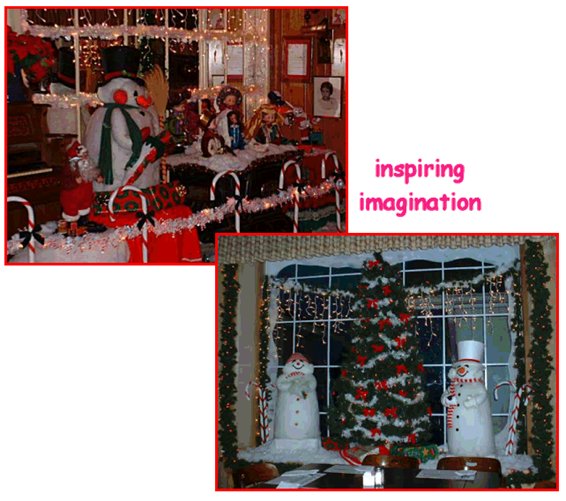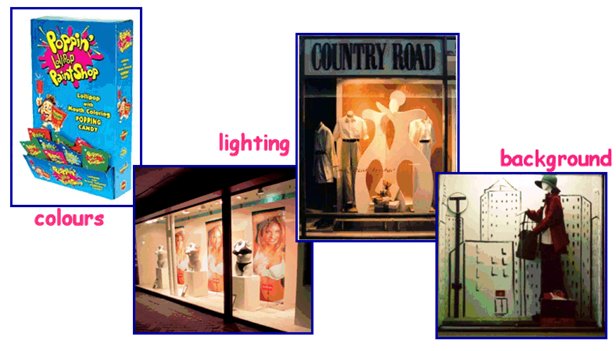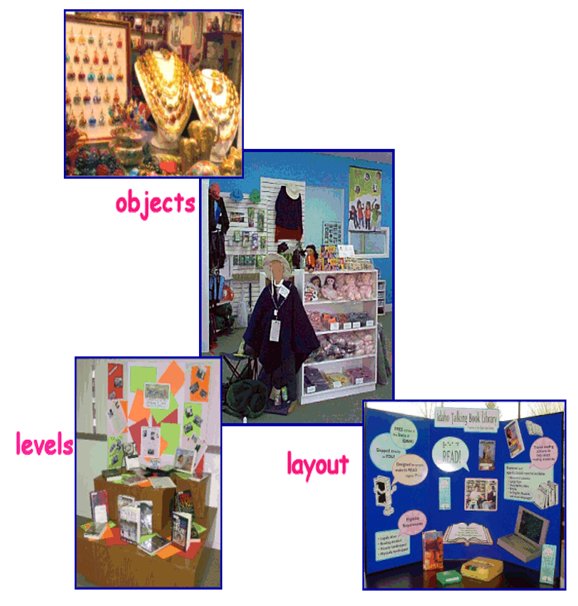Retailers spend millions of dollars on market research to identify what entices customers to buy and what turns them off
So you don’t have to be an interior designer (frustrated or otherwise) to landscape your library. Every time you go shopping, look at displays and how they are constructed and then take the ideas and elements and reproduce them.
Think of it as recycling – their research and its output into your environment – two displays for the cost of one!
There are many subtle ways that they get us to part with our money. Consider how you might employ some of these tempters in your library.
- Look at the colours that are used to attract the eye – the younger generation likes garish and bright, not moody and subtle
- Different levels of lighting literally create variations of light and shade, and thus, different levels of emotions. Although your reading corner should be near natural light, add a regular reading lamp to build atmosphere. Ensure workspaces are brightly lit but illuminate special displays with soft, gentle lighting to help draw attention to the space it helps define. Christmas lights can add sparkle to displays all year round.
- Create different levels within a display by using boxes covered in wrapping paper to suit the theme or brown paper, stands, and other paraphernalia that can be repurposed. Suspend or mount appropriate props that help tell the story and purpose of the display. Create curiosity by having books peep out from props. If you have access to a local bookshop, ask if you can have their dumpbins and other stands used to promote new releases when they are finished with them. You can turn the header inside out to make your own that fits. If other shops have props that you could use, ask if you can borrow them when they’ve finished with them.
- Music and sound effects can also add atmosphere to a display, but keep the volume low out of consideration for all users.
- Commercial bookstores have incorporated coffee bars because they know the invitation of the smell of hot coffee and home-cooking but this is probably not a practical option. Researchers have also looked at the role of smell in stimulating the brain and aromatherapy is now making its way into classrooms. But think of those with allergies – even a simple vase of fresh flowers can be a trigger.
- Use objects that the students can touch and investigate so the display becomes interactive.
- A small display of a book or a puzzle where students line up for check-out can engage the imagination and ensure appropriate behaviour in line. Think of it in terms of the magazine or lolly displays at the supermarket check-out.
- Place your returns box and checkout counter near the main exit but allow enough space for one class to be coming in while another is checking out.
- Have an enticing main display near the entrance to not only to attract visitors but also give those waiting in the checkout queue something to look at and maybe borrow. Books placed here can increase circulation exponentially.
- Be aware of traffic aisles, especially those to emergency exits. Watch where your students go as soon as they come in and make sure the pathway is wide enough. If you want to highlight a ‘slow’ section of your collection, make the display near this pathway.
- Hard floor surfaces are used where customers are moving from one section to another, but to encourage browsing, carpet is used. If you have a special area where you want the children to linger longer, add a rug on top of the carpet.
- Use short, low shelving to maintain the feel of openness and create extra area for signage and displays on the ends. In the elementary library, no shelf should be higher than the youngest child can reach. Stools and steps invite accidents but if you do have tall shelves, put these near walls. Consider using the top shelves for displays only. Be aware of the mandatory federal and state Disability Standards for Education so your layout complies with these.
- Although shelving by genre is an easier option for bookstores than libraries, research shows that this does increase circulation. Rather than reorganizing your whole library, use the sorts of sections already suggested and complement these with bookmarks that suggest other titles by the author, other titles in the genre, other titles on the subject and “If you like … try …”
- Include a “Recommended Reads” section near your circulation desk to temporarily house the students’ current favorites, and slip a card in the cover saying who recommended it.
20 Top Tips
- Look at the displays in shop windows. Analyse what attracted you, how it is constructed and how you can adapt it.
- All resources on display must be able to be borrowed at the time so the child’s curiosity can be satisfied immediately. Select topic which can be supported with plenty of resources.
- Get ideas for layouts and fripperies from scrapbooking magazines
- Increase reading opportunities by creating captions for everything on display
- Create challenges for the students based on the display. If your theme is flight, investigate which style of paper airplane flies the longest distance. Consider using the display as a draw card for raising funds for charity
- Cover large boxes with fabric to increase display space and present books between eye and waist level.
- Swathes of fabric are excellent for backdrops and ceilings and covering surfaces. They define the space, “lower” high ceilings and are reusable. Look for texture as well as color and pattern as children like to touch them
- Christmas lights and decorations make glitzy additions to fantasy displays
- Use fishing line for strength, durability and invisibility when hanging things
- Look at using everyday materials in different ways.
- Calendars are an excellent source of pictures for country landscapes, artists’ works, theme timelines, animals. Buy them in mid-January when they are heavily discounted.
- Some displays can be semi-permanent such as a Happy Birthday display. All you have to do is change the subject and add appropriate resources.
- Make displays interactive so children can become involved with them
- Use as much children’s work as possible
- View your displays as presentation models for students so they learn what elements are important and how they can be arranged.
- Create displays that are not the center of current classroom instruction. Even though it is tempting to integrate in this way, the resources need to be in use in the classrooms. Think about a related topic that might take students on a new voyage of discovery
- Encourage classes or your student assistants to create a display
- Get to know your local El Cheapos, charity stores and recycling shops well
- Always give your display a catchy title and consider music and lighting.
- Remember your imagination is your best friend and closest ally.




